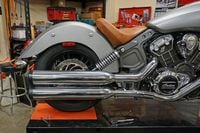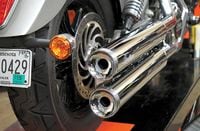Wrist: Brian Hatano
MSRP (2015): $11,299
Miles: 4,795
MPG: 43
Mods: ECU calibration, sound check
Update: 6
Shortly after the last installment on the Indian Scout, it was called in for the update that would solve the pre-production fueling issue of a low-fuel warning light that was failing to warn (all production Scouts are free of this minor glitch). While the update was being performed, we had the fleet center perform the recommended ECU calibration for the Straights slip-on exhaust. As soon as the bike was returned we rolled it onto our dyno.
The results: 87.6 hp at 7,900 rpm with 64.9 pound-feet of torque at 3,400. The numbers were virtually identical to the baseline 88 hp at 7,800 and 64.8 pound-feet at 5,850. When you compare the two charts, the stock (before reflash) and slip-on traces are very similar up to about 6,500 rpm, where the stock bike keeps rising to a peak just before 8,000 rpm. With the reflash and the slip-ons, the Scout’s hardy V-twin lost a bit of power compared to stock, starting at 6,500 rpm and continuing through about 7,800 rpm; it carried on slightly longer than stock, however. The point is this: There’s no effective change in power where most riders will enjoy the Scout. And Indian, for its part, agrees, calling the slip-on system mainly a way to get a throatier exhaust note.
In the last update, we pulled a description from the Indian Motorcycle website that said the Straights slip-ons would allow the engine to “breathe more freely and unleash additional power; especially enhanced midrange torque and crisp throttle response.”
After sharing our dyno numbers with Indian reps and inquiring why our results did not reflect any additional power, it was discovered that the description was erroneously copied from one of Indian’s previous exhaust systems. The copy was immediately removed from the website and will be replaced with the following description: “Add the 49 State Stage 1 Straights Slip-On Exhaust to an Indian® Scout™ motorcycle and enjoy a rich, throaty exhaust note that provides the perfect soundtrack for the open road. The exhaust is SAE J2825 compliant and certified to meet EPA & CARB emissions limits and also includes EFI recalibration by Indian® Motorcycle dealers. Dealer installation is required.”
So there was no huge increase to brag about here (although the reflash seemed to help smooth out an off-idle stumble on acceleration), but let’s be honest, we weren’t really going for more power with this mod. It was all about that sound.
Passing under the radar for noise might not be a top priority depending on where you live, but here in the LA/OC counties, there are several local police departments that are sticklers about bikes with loud pipes. So to make sure the Scout’s louder bark would not attract undue attention, I broke out our digital sound meter to get a reading on decibels per J2825 standard.
J2825 was established by the Motorcycle Industry Council (MIC) and Society of Automotive Engineers (SAE) as a test procedure that can be conducted in the field with consistent results. The procedure, which is supported by the AMA, uses a calibrated sound meter positioned 20 inches away from the exhaust outlet at a 45-degree angle. The test must be conducted in an open area with a minimum eight feet of unobstructed space all around. The sound limits are as follows:
- All motorcycles must not exceed 92 dBA at idle.
- Motorcycles with less than three or more than four cylinders are limited to 96 dBA at 2,000 rpm.
- Motorcycles with three or four cylinders are limited to 100 dBA at 5,000 rpm.
We performed a baseline sound test on the Scout that registered 83 dBA with stock mufflers. Without moving the motorcycle, we swapped to the Straights slip-ons and re-ran the test. The tone of the exhaust deepened noticeably but still measured well below the J2825 limits: 85 dBA at idle and 88 dBA at two grand.
With the Indian logo clearly visible on the top muffler and a healthier but still-compliant sound, the Indian Straights are a good choice if you want to keep your mods factory and hassle-free. Coming up, I’ll experiment with a Trask two-into-one exhaust and an aftermarket tuning module.















/cloudfront-us-east-1.images.arcpublishing.com/octane/7GJYDUIPXRGMTMQKN6ONYOLBOU.jpg)
/cloudfront-us-east-1.images.arcpublishing.com/octane/MUQLOVLL2ZDGFH25ILABNBXKTI.jpg)
/cloudfront-us-east-1.images.arcpublishing.com/octane/TNOU5DNE2BC57MFPMGN2EIDXAM.jpg)
/cloudfront-us-east-1.images.arcpublishing.com/octane/GTCXACQGJ5HAPDTGWUQKDEH44E.jpg)
/cloudfront-us-east-1.images.arcpublishing.com/octane/S35YGSEMEZB4BLTDJTSZPF4GLA.jpg)
/cloudfront-us-east-1.images.arcpublishing.com/octane/5UOT6HPX2JFMRJAX6EH45AR4MQ.jpg)
/cloudfront-us-east-1.images.arcpublishing.com/octane/OKWOJWAKP5EP3OACCRRWPCIX2Q.jpg)
/cloudfront-us-east-1.images.arcpublishing.com/octane/2WF3SCE3NFBQXLDNJM7KMXA45E.jpg)
/cloudfront-us-east-1.images.arcpublishing.com/octane/G4MG6OUCJNBSHIS2MVVOTPX65E.jpg)
/cloudfront-us-east-1.images.arcpublishing.com/octane/IIGGWFOTOJGB7DB6DGBXCCMTDY.jpg)
/cloudfront-us-east-1.images.arcpublishing.com/octane/QSTCM6AVEZA5JJBUXNIQ3DSOF4.jpg)
/cloudfront-us-east-1.images.arcpublishing.com/octane/U4I7G625B5DMLF2DVIJDFZVV6M.jpg)
/cloudfront-us-east-1.images.arcpublishing.com/octane/B6XD6LS6IVCQPIU6HXDJSM3FHY.jpg)
/cloudfront-us-east-1.images.arcpublishing.com/octane/ICL63FEDDRDTTMINYICCEYGMDA.jpg)
/cloudfront-us-east-1.images.arcpublishing.com/octane/FCGZHQXRBZFLBAPC5SDIQLVF4I.jpg)
/cloudfront-us-east-1.images.arcpublishing.com/octane/WNOB6LDOIFFHJKPSVIWDYUGOPM.jpg)

/cloudfront-us-east-1.images.arcpublishing.com/octane/X33NU3E525ECRHXLNUJN2FTRKI.jpg)
/cloudfront-us-east-1.images.arcpublishing.com/octane/6KKT5NNL2JAVBOXMZYS5ZO76YA.jpg)
/cloudfront-us-east-1.images.arcpublishing.com/octane/J5RKG5O455GMPGQRF2OG6LRT7A.jpg)
/cloudfront-us-east-1.images.arcpublishing.com/octane/GX2CIZKQVRH2TATDM26KFG2DAE.jpg)
/cloudfront-us-east-1.images.arcpublishing.com/octane/ZWIDYSAKQZHD5BHREMQILXJCGM.jpg)
/cloudfront-us-east-1.images.arcpublishing.com/octane/CYUHJZCTSJCH3MRAQEIKXK7SCQ.jpg)
/cloudfront-us-east-1.images.arcpublishing.com/octane/LKOFINY56FCXJCANJ5M7ZDQUBY.jpg)